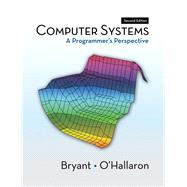For Computer Systems, Computer Organization and Architecture courses in CS, EE, and ECE departments.
Few students studying computer science or computer engineering will ever have the opportunity to build a computer system. On the other hand, most students will be required to use and program computers on a near daily basis.
Computer Systems: A Programmer’s Perspective introduces the important and enduring concepts that underlie computer systems by showing how these ideas affect the correctness, performance, and utility of application programs. The text's hands-on approach (including a comprehensive set of labs) helps students understand the “under-the-hood” operation of a modern computer system and prepares them for future courses in systems topics such as compilers, computer architecture, operating systems, and networking.
This book explains the important and enduring concepts underlying all computer systems, and shows the concrete ways that these ideas affect the correctness, performance, and utility of application programs.
The book's concrete and hands-on approach will help readers understand what is going on "under the hood" of a computer system. This book focuses on the key concepts of basic network programming, program structure and execution, running programs on a system, and interaction and communication between programs.
For anyone interested in computer organization and architecture as well as computer systems.









